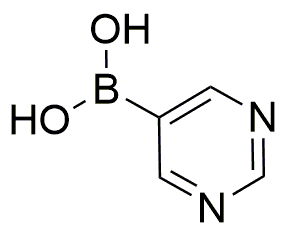5-Pyrimidylboronic acid is widely utilized in research focused on:
- Drug Development: This compound plays a crucial role in the synthesis of various pharmaceuticals, particularly in the development of targeted therapies for cancer. Its ability to form stable complexes with biomolecules enhances drug efficacy.
- Bioconjugation: It is commonly used in bioconjugation processes, allowing researchers to attach biomolecules to surfaces or other molecules. This is particularly useful in creating targeted drug delivery systems and diagnostic tools.
- Organic Synthesis: In organic chemistry, it serves as a versatile building block for synthesizing complex organic compounds. Its unique properties make it an excellent choice for creating new materials with specific functionalities.
- Sensor Technology: The compound is applied in the development of chemical sensors, particularly for detecting glucose levels in diabetic patients. Its sensitivity and selectivity make it a valuable component in biosensor design.
- Material Science: It is utilized in the fabrication of advanced materials, such as polymers and nanomaterials, that have applications in electronics and photonics, enhancing the performance of devices.
General Information
Properties
Safety and Regulations
Applications
5-Pyrimidylboronic acid is widely utilized in research focused on:
- Drug Development: This compound plays a crucial role in the synthesis of various pharmaceuticals, particularly in the development of targeted therapies for cancer. Its ability to form stable complexes with biomolecules enhances drug efficacy.
- Bioconjugation: It is commonly used in bioconjugation processes, allowing researchers to attach biomolecules to surfaces or other molecules. This is particularly useful in creating targeted drug delivery systems and diagnostic tools.
- Organic Synthesis: In organic chemistry, it serves as a versatile building block for synthesizing complex organic compounds. Its unique properties make it an excellent choice for creating new materials with specific functionalities.
- Sensor Technology: The compound is applied in the development of chemical sensors, particularly for detecting glucose levels in diabetic patients. Its sensitivity and selectivity make it a valuable component in biosensor design.
- Material Science: It is utilized in the fabrication of advanced materials, such as polymers and nanomaterials, that have applications in electronics and photonics, enhancing the performance of devices.
Documents
Safety Data Sheets (SDS)
The SDS provides comprehensive safety information on handling, storage, and disposal of the product.
Product Specification (PS)
The PS provides a comprehensive breakdown of the product’s properties, including chemical composition, physical state, purity, and storage requirements. It also details acceptable quality ranges and the product's intended applications.
Certificates of Analysis (COA)
Search for Certificates of Analysis (COA) by entering the products Lot Number. Lot and Batch Numbers can be found on a product’s label following the words ‘Lot’ or ‘Batch’.
*Catalog Number
*Lot Number
Certificates Of Origin (COO)
This COO confirms the country where the product was manufactured, and also details the materials and components used in it and whether it is derived from natural, synthetic, or other specific sources. This certificate may be required for customs, trade, and regulatory compliance.
*Catalog Number
*Lot Number
Safety Data Sheets (SDS)
The SDS provides comprehensive safety information on handling, storage, and disposal of the product.
DownloadProduct Specification (PS)
The PS provides a comprehensive breakdown of the product’s properties, including chemical composition, physical state, purity, and storage requirements. It also details acceptable quality ranges and the product's intended applications.
DownloadCertificates of Analysis (COA)
Search for Certificates of Analysis (COA) by entering the products Lot Number. Lot and Batch Numbers can be found on a product’s label following the words ‘Lot’ or ‘Batch’.
*Catalog Number
*Lot Number
Certificates Of Origin (COO)
This COO confirms the country where the product was manufactured, and also details the materials and components used in it and whether it is derived from natural, synthetic, or other specific sources. This certificate may be required for customs, trade, and regulatory compliance.


